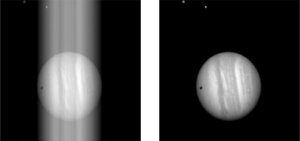Reposted from http://pluto.jhuapl.edu/News-Center/Science-Shorts.php?page=ScienceShorts_07_11_2014.
You walk up to the Restaurant at the End of the Solar System, ready to try that slice of “Pluto on ice” that you heard amazing things about. The chef behind the counter asks, “So, how would you like your data? “ Without hesitation, you reply “Well calibrated.”
Pretty pictures or spectra make no sense “without context.” For images, we need to know how many kilometers map to a pixel and for each raw digitized value, a mapping from bits to energy units (like magnitude or ergs/cm^2/s). For spectra, we need to know how much spatial information is covered per pixel plus what each pixel’s response to wavelength and brightness is. For particle instruments, we need to what energy and from which direction that ion or dust grain came.
Before launch every New Horizons instrument underwent intensive laboratory characterization: “pre-flight calibration.” They were subject to spatial targets, integrating spheres, laser pulses, particle accelerators, to name a few good “known” sources, to get “translations” from bits stored to disk to “real” units like wavelength, flux energy, intensity, etc. After launch such “translations” were verified with “in-orbit” calibrations, where, for example, instead of a lab source, the instruments stared at stars or inspected Jupiter and its moons. Each year, the team executes an ACO, or Annual Check-Out, where instrument performances are trended and teams look for changes. Additional observations provide information to remove “unwanted artifacts” like hot-pixels, readout smearing, ghosts, etc.
Summer 2014 is ACO-8, our 8th annual checkout since launch. It showcases our last calibrations prior to the 2015 Pluto encounter. It’s jammed packed with observations that are done yearly for trending, but also some new ones to make sure the New Horizons instrument suite is “well calibrated.” Highlights include new radiometric calibrations for the LEISA IR spectrometer, a long stability test for the REX radio experiment, and a test for revised thresholds for PEPSSI, the high-energy particle detector. More calibration data is taken during the 2015 Pluto fly-by, and together, these data sets are placed in the data reduction pipeline to translate bits to “real” values. Resources and time aboard the spacecraft to execute these observations are limited, so a series of reviews and assessments are done prior to each checkout.
The team is eager to get the data from ACO-8. We wake up June 15th. After a similar series of spacecraft subsystem checkouts, the New Horizons payload calibrations begin and continue through August. It may not be the Pluto fly-by, but this summer’s data will play a big role in the science return from New Horizons next year!

Demonstration of read-out smear removal, preserving the photon count, in LORRI’s calibration pipeline. The data in the smear is caused by imperfections in the CCD readout when illuminated by a lot of light. The source of the photons is from the object being imaged, so we need to correctly relocate the information. Data without good calibration is messy.
As a New Horizons deputy project scientist, Kimberly Ennico manages instrument readiness and calibration aspects of the mission. Her expertise includes instrument development, space qualification and calibration; optical/infrared astronomy; optical/infrared detectors, optics, cameras and spectrometers; and science communication.
